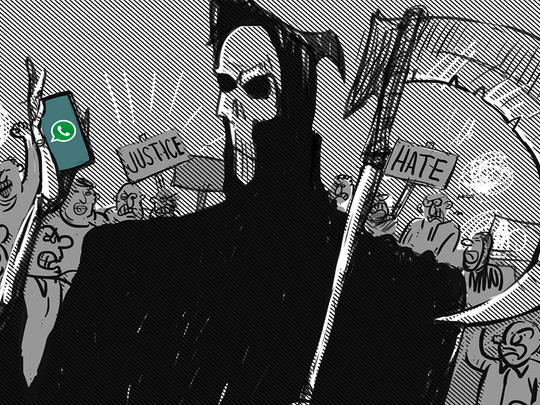
A fire is going around India. A raging, murderous fire that is turning ordinary folks into killers and consuming innocents who are being killed. In the last six weeks at least 18 people have been lynched in different parts of the country over suspicion that they were child abductors. A single WhatsApp rumour, a piece of pernicious fake news blithely forwarded, is now enough to make people take leave of their senses, shed their humanity, and mutate into a mob that wants to draw blood.
The latest incident, which took place on July 1, resulted in the killing of five men in Dhule in the state of Maharashtra. WhatsApp messages had been going around for days warning people that a gang of child kidnappers was on the prowl. No one knew who was posting the messages. But that did not matter — everyone believed them to be true. So when five strangers turned up in the area one morning, the locals immediately assumed they were the culprits. Suspicion was sufficient — proof unnecessary. It wasn’t long before a mob of 35 people, including a few children, rounded on them and beat them to death. It later turned out that the victims belonged to an impoverished nomadic community who had likely come to the area to seek alms.
Similar acts of mindless brutality have taken place in states such as Assam, Tripura, West Bengal, Jharkhand, Karnataka and others. People are being bludgeoned to death solely on the basis of wild social media rumours. Rule of law has been cast to the four winds.
How did we get here?
The easiest and the most convenient explanation is that the masses are gullible, and now that millions of Indians have access to the internet via their smart phones, they are easily swayed by such things as WhatsApp forwards, especially the incendiary, fake ones. Hence — so goes the argument — social media misinformation on child traffickers is making the credulous whip themselves up into a frenzy and take the law into their own hands.
Last week the Indian government rapped out a stern directive to WhatsApp, the Facebook-owned messaging service, asking it to check the spread of fake news. WhatsApp responded by announcing certain steps to make it tougher to forward messages. But as things stand, WhatsApp’s end-to-end encryption does not allow it to access the messages on its platform, far less intercept or block them.
The point, however, is that while fake news, propelled by technology, has certainly sparked the current spate of lynchings, one cannot attribute them only to the so-called gullibility of neo-converts to the internet. In truth, the killings are part of a larger pattern of fear and loathing for the “other” that India has witnessed in recent times.
In 2015, a 52-year-old man named Mohammad Akhlaq was lynched in Dadri in Uttar Pradesh because the mob believed that he had hoarded beef in his house, which is unlawful in that state. Since then, cow vigilantes have struck at regular intervals. They have beaten and killed at will; they have flogged Dalits (members of the socially disadvantaged lower castes) for committing no greater sin than carrying the carcass of a dead bovine. And they have often been defended by sundry ministers and lawmakers belonging to the ruling Bharatiya Janata Party. So much so that when one of the accused in the Dadri lynching case died, a local leader had his coffin covered with the national flag — as though he were a hero and his crime an act of national pride.
All this has created a chilling atmosphere of impunity, a sense that mere suspicion of wrongdoing is reason enough to kill, and that you may in fact get away with it because you’re targeting the despicable “other” — the minorities, the disadvantaged, the outsider or the outlier.
The lynching of alleged child-kidnappers springs from this same majoritarian thuggery and murderousness. Yes, some people may be suggestible. They may be susceptible to mala fide rumours. But what fuels the extreme violence of their action? Their easy, instantaneous slide into butchery? The answer lies in the mainstreaming of hate in India today. Whether online or off, hate is now an unbridled, radioactive thing that spawns still more hate. And a few lynch mobs too.
To take a recent example, after the brutal rape of an eight-year-old girl in Mandsaur in the state of Madhya Pradesh last month, a Hindutva-spewing website put out Photoshopped images of Muslim men holding up placards in support of the rapists. (The reality was just the opposite — they had marched demanding justice for the victim.) The images went viral, triggering a blast of communal hatred on social media.
And what of the government that has thundered so righteously at WhatsApp and ordered it to rein in fake news? Well, it did absolutely nothing to stamp out this dangerous misinformation in its own backyard.
Indeed, the atmosphere is so polarised now that even foreign minister Sushma Swaraj, who belongs to the BJP, bore the brunt of it when she went against the communal grain. Online mobs — allegedly the BJP’s own pet trolls — attacked her viciously when her ministry transferred an official who had refused to renew the passports of an inter-faith couple. Swaraj was seen to be repudiating her own and supporting the “other” — and that made them come at her with virtual sticks and stones.
India’s lynch mobs are rising from this hate-filled swamp. They are feeding richly on this culture of divisiveness. And whether they are communal or secular, whether they attack Muslim cattle traders or those they believe to be child-kidnappers, they are pushing the country into a sort of lawless medievalism that is as terrifying as it is tragic.
Shuma Raha is a senior journalist based in Delhi.










